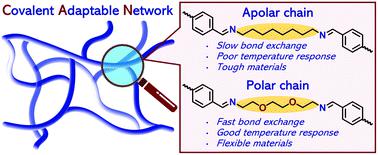当前位置:
X-MOL 学术
›
Polym. Chem.
›
论文详情
Our official English website, www.x-mol.net, welcomes your feedback! (Note: you will need to create a separate account there.)
The effect of polarity on the molecular exchange dynamics in imine-based covalent adaptable networks
Polymer Chemistry ( IF 4.6 ) Pub Date : 2020-12-9 , DOI: 10.1039/d0py01555e Sybren K. Schoustra 1, 2, 3, 4 , Timo Groeneveld 1, 2, 3, 4 , Maarten M. J. Smulders 1, 2, 3, 4
Polymer Chemistry ( IF 4.6 ) Pub Date : 2020-12-9 , DOI: 10.1039/d0py01555e Sybren K. Schoustra 1, 2, 3, 4 , Timo Groeneveld 1, 2, 3, 4 , Maarten M. J. Smulders 1, 2, 3, 4
Affiliation

|
Covalent adaptable networks (CANs) are a rising type of polymeric materials that consist of covalently crosslinked polymer chains, but with the inclusion of dynamic covalent bonds, and that can perform bond exchange reactions under equilibrium control. The dynamic behaviour of these exchange reactions within a polymer matrix has been established to be a key parameter in the control of the material properties. Therefore, in order to fully control the macroscopic material properties of CANs, understanding the underlying molecular exchange processes of these dynamic covalent bonds is essential. In this work, we studied the effect of polarity in polyimine-based CANs, and considered not only the network response itself, but also the – so far often overlooked – effect on the exchange dynamics. By combining results from kinetic studies and material analysis we were firstly able to show a distinct correlation between the presence of polar domains in the molecular structure and the thermal and dynamic mechanical properties of the materials. More importantly, the presence of polar domains also greatly affected the exchange kinetics of the dynamic imine bonds. On the molecular level, we showed that the imine exchange could be greatly enhanced (up to 20 times) when polar groups were present near the reactive imine species. As a result, in our polymer materials we established a tuneable range of phase transition temperatures from glass-to-rubber and rubber-to-liquid over roughly 100 °C as a result of either presence or absence of polar groups in the polymer matrix. Furthermore, detailed analysis in the stress relaxation behaviour of the polyimine materials revealed three relaxation processes, which we could attribute to the relaxation in network topology, to the imine exchange on a local level, and to the imine exchange as a result of diffusion through the polymer network. From this analysis we were also able to illustrate the effect of polarity on the polymer network to each of the three relaxation mechanisms.
中文翻译:

极性对基于亚胺的共价自适应网络中分子交换动力学的影响
共价适应性网络(CAN)是一种新兴的聚合材料,由共价交联的聚合物链组成,但包含动态共价键,并且可以在平衡控制下进行键交换反应。这些交换反应在聚合物基体内的动力学行为已被确定为控制材料性能的关键参数。因此,为了完全控制CAN的宏观材料特性,了解这些动态共价键的潜在分子交换过程至关重要。在这项工作中,我们研究了基于聚亚胺的CAN中极性的影响,不仅考虑了网络响应本身,而且还考虑了迄今为止常常被忽视的对交换动力学的影响。通过结合动力学研究和材料分析的结果,我们首先能够显示出分子结构中极性域的存在与材料的热力学和动态力学性能之间的明显相关性。更重要的是,极性结构域的存在也极大地影响了动态亚胺键的交换动力学。在分子水平上,我们表明当反应性亚胺类附近存在极性基团时,亚胺的交换可以大大增强(最多20倍)。结果,在我们的聚合物材料中,由于聚合物基体中存在或不存在极性基团,我们在大约100°C的温度范围内建立了从玻璃到橡胶,橡胶到液体的可调节相变温度范围。此外,聚亚胺材料的应力松弛行为的详细分析显示了三个松弛过程,我们可以将其归因于网络拓扑结构的松弛,局部水平上的亚胺交换以及由于通过聚合物网络扩散而产生的亚胺交换。 。通过该分析,我们还能够说明极性对三种松弛机理中的每一种对聚合物网络的影响。
更新日期:2020-12-22
中文翻译:

极性对基于亚胺的共价自适应网络中分子交换动力学的影响
共价适应性网络(CAN)是一种新兴的聚合材料,由共价交联的聚合物链组成,但包含动态共价键,并且可以在平衡控制下进行键交换反应。这些交换反应在聚合物基体内的动力学行为已被确定为控制材料性能的关键参数。因此,为了完全控制CAN的宏观材料特性,了解这些动态共价键的潜在分子交换过程至关重要。在这项工作中,我们研究了基于聚亚胺的CAN中极性的影响,不仅考虑了网络响应本身,而且还考虑了迄今为止常常被忽视的对交换动力学的影响。通过结合动力学研究和材料分析的结果,我们首先能够显示出分子结构中极性域的存在与材料的热力学和动态力学性能之间的明显相关性。更重要的是,极性结构域的存在也极大地影响了动态亚胺键的交换动力学。在分子水平上,我们表明当反应性亚胺类附近存在极性基团时,亚胺的交换可以大大增强(最多20倍)。结果,在我们的聚合物材料中,由于聚合物基体中存在或不存在极性基团,我们在大约100°C的温度范围内建立了从玻璃到橡胶,橡胶到液体的可调节相变温度范围。此外,聚亚胺材料的应力松弛行为的详细分析显示了三个松弛过程,我们可以将其归因于网络拓扑结构的松弛,局部水平上的亚胺交换以及由于通过聚合物网络扩散而产生的亚胺交换。 。通过该分析,我们还能够说明极性对三种松弛机理中的每一种对聚合物网络的影响。



























 京公网安备 11010802027423号
京公网安备 11010802027423号